Booby
A booby is a seabird in the genus Sula, part of the family Sulidae. Boobies are closely related to the gannets (Morus), which were formerly included in Sula.
| Booby Temporal range: Miocene (Langhian)-recent[1] | |
|---|---|
_-one_leg_raised.jpg) | |
| Blue-footed booby displaying by raising a foot | |
| Scientific classification | |
| Kingdom: | Animalia |
| Phylum: | Chordata |
| Class: | Aves |
| Order: | Suliformes |
| Family: | Sulidae |
| Genus: | Sula Brisson, 1760 |
| Type species | |
| Pelecanus leucogaster Boddaert, 1783 | |
| |||||||||||||||||||||||||||||||||
| Cladogram showing the species in the genus Sula.[2] |
Systematics and evolution
The genus Sula was introduced by the French zoologist Mathurin Jacques Brisson in 1760.[3] The type species is the brown booby.[4] The name is derived from súla, the Old Norse and Icelandic word for the other member of the family Sulidae, the gannet.[5]
The English name "booby" was possibly based on the Spanish slang term bobo, meaning "stupid",[6] as these tame birds had a habit of landing on board sailing ships, where they were easily captured and eaten. Owing to this, boobies are often mentioned as having been caught and eaten by shipwrecked sailors, notably William Bligh of the Bounty and his adherents during their famous voyage after being set adrift by Fletcher Christian and his followers.
Six of the ten extant Sulidae species called boobies are in the genus Sula, while the three gannet species are usually placed in the genus Morus.[7] Abbott's booby was formerly included in Sula but is now placed in a monotypic genus Papasula, which represents an ancient lineage perhaps closer to Morus.
Some authorities consider that all ten species should be considered congeneric in Sula. However, they are readily distinguished by means of osteology. The distinct lineages of gannets and boobies are known to have existed in such form, since at least the Middle Miocene, c.15 mya.[8]
The fossil records of boobies are not as well documented as those of the gannets; possibly because the species of boobies were less numerous in the late Miocene to Pliocene, when gannets had their highest diversity or because of the more tropical distribution of boobies, many fossil species have simply not been found yet, as most localities are in continental North America or Europe.
Behaviour
Boobies hunt fish by diving from a height into the sea and pursuing their prey underwater. Facial air sacs under their skin cushion the impact with the water. Boobies are colonial breeders on islands and coasts. They normally lay one or more chalky-blue eggs on the ground or sometimes in a tree nest. Selective pressures, likely through competition for resource, have shaped the ecomorphology and foraging behaviours of the six species of boobies in the Pacific.[9]
List of species
| Common name | Scientific name | IUCN Red List Status | Distribution | Picture |
|---|---|---|---|---|
| Blue-footed booby | Sula nebouxii Milne-Edwards, 1882 |
LC IUCN[10] | _world2.png) |
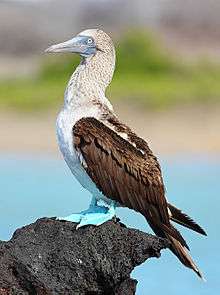 |
| Brown booby | Sula leucogaster (Boddaert, 1783) |
LC IUCN[11] | 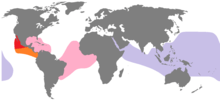 |
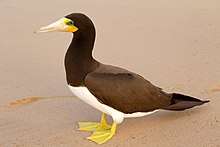 |
| Masked booby | Sula dactylatra Lesson, 1831 |
LC IUCN[12] | 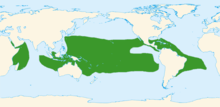 |
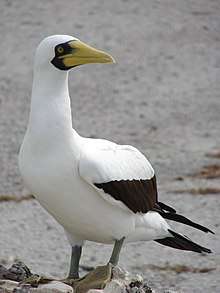 |
| Nazca booby | Sula granti Rothschild, 1902 |
LC IUCN[13] |  | |
| Peruvian booby | Sula variegata (Tschudi, 1843) |
LC IUCN[14] | 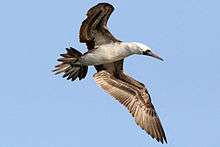 | |
| Red-footed booby | Sula sula (Linnaeus, 1766) |
LC IUCN[15] | 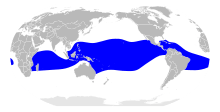 |
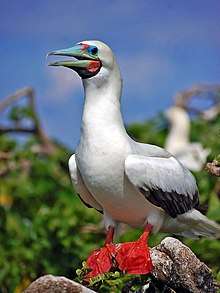 |
References
- "Sula Brisson 1760 (booby)". PBDB.
- Patterson, S.A.; Morris-Pocock, J.A.; Friesen, V.L (2011). "A multilocus phylogeny of the Sulidae (Aves: Pelecaniformes)". Molecular Phylogenetics and Evolution. 58 (2): 181–191. doi:10.1016/j.ympev.2010.11.021.
- Brisson, Mathurin Jacques (1760). Ornithologie, ou, Méthode contenant la division des oiseaux en ordres, sections, genres, especes & leurs variétés (in French and Latin). Volume 1. Paris: Jean-Baptiste Bauche. Vol. 1 p. 60, Vol. 6 p.494.
- Mayr, Ernst; Cottrell, G. William, eds. (1979). Check-list of Birds of the World. Volume 1 (2nd ed.). Cambridge, Massachusetts: Museum of Comparative Zoology. p. 181.
- "Sula, n.". Oxford English Dictionary (3rd ed.). Oxford University Press. September 2005. (Subscription or UK public library membership required.)
- "booby, n.". Oxford English Dictionary (3rd ed.). Oxford University Press. September 2005. (Subscription or UK public library membership required.)
- Friesen, V. L.; Anderson, D. J.; Steeves, T.E.; Jones, H.; Schreiber, E.A. (2002). "Molecular support for species status of the Nazca Booby". The Auk. 119 (3): 820–826. doi:10.1642/0004-8038(2002)119[0820:MSFSSO]2.0.CO;2.
- Olson, Storrs L. "The Fossil Record of Birds (Section X.G.5.a Sulidae)". In Farner, D.S.; King, D.S.; Parkes, K.C. (eds.). Avian Biology. Volume 8. New York: Academic Press. pp. 79–238 [203–204].
- van Oordt, F.; Torres-Mura, J. C.; Hertel, F. (2018). "Ecomorphology and foraging behaviour of Pacific boobies". Ibis. 160 (2): 313–326. doi:10.1111/ibi.12545.
- BirdLife International (2012). "Sula nebouxii". IUCN Red List of Threatened Species. 2012. Retrieved 26 November 2013.CS1 maint: ref=harv (link)
- BirdLife International (2012). "Sula leucogaster". IUCN Red List of Threatened Species. 2012. Retrieved 2013-11-26.CS1 maint: ref=harv (link)
- BirdLife International (2012). "Sula dactylatra". IUCN Red List of Threatened Species. 2012. Retrieved 26 November 2013.CS1 maint: ref=harv (link)
- BirdLife International (2012). "Sula granti". IUCN Red List of Threatened Species. 2012.CS1 maint: ref=harv (link)
- BirdLife International (2012). "Sula variegata". IUCN Red List of Threatened Species. 2012. Retrieved 26 November 2013.CS1 maint: ref=harv (link)
- BirdLife International (2012). "Sula sula". IUCN Red List of Threatened Species. 2012. Retrieved 26 November 2013.CS1 maint: ref=harv (link)
External links
| Wikimedia Commons has media related to Sula. |